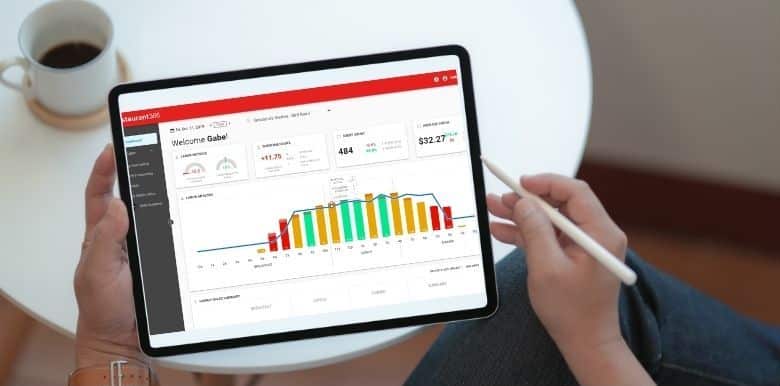For 21st-century companies, data is a powerful tool that can help improve nearly every area of business. Data can be used to streamline operations, provide better customer service, and drive strategic decisions.
But when most people talk about data, they’re usually speaking about the tools and technology that can be used to track, process, and analyze information. And while these tools are certainly useful, creating a successful, data-driven business isn’t just about having the data.
To be successful, your organization needs to create a culture of actually using data. After all, the ultimate purpose of having data is to help you make impactful decisions.
For many restaurant businesses, in particular, tracking data is one thing, but getting your team to use it for decision making may be the bigger challenge.
How do you get your store-level managers and other leadership to convert data into actionable insights? Let’s explore how to build a data-driven culture for your restaurant group.
What is a data-driven culture?
Ultimately, data is an asset of the company, just like other assets (such as time-saving equipment). In a data-driven restaurant culture, all stakeholders – store-level managers to C-level ops and finance – leverage the same data for decision making. They’re leveraging data as an asset, facilitating and championing business decisions based on data.
Data is information captured and compiled from across the business. A data-driven culture focuses on applying data to specific operations to learn what works and what doesn’t to improve processes. In addition, within a data-driven culture, data is accessible to all stakeholders, from those at the store level to corporate finance and operations executives.
For a data-driven culture to succeed, your team needs to have both the data and the knowledge to leverage it in a way that helps the business. Anyone within the restaurant business who has the ability to impact efficiency and profitability must not only be part of that culture but must understand how to use data to affect business outcomes.
Why it’s important to have a data-driven culture in a restaurant business
The ultimate goal of using data is to increase profitability. Data can impact profitability in a number of ways. It can monitor performance, improve processes and even inform your growth objectives.
Think about how many transactions you do in a day. Add in all of the invoices, orders, and inventory you are tracking. Combine that with the labor hours and complex payroll information as well. That’s a lot of data that you can potentially use to improve your operations.
But having this data stored in your point of sale (POS) system or other restaurant systems doesn’t mean anything by itself. Your data needs to be applied strategically to be valuable.
For restaurants in particular, a data-driven culture can help provide insight you can use to improve operations and profitability.
Many restaurants are accustomed to operating on weekly, monthly, or quarterly reporting. While these check-ins are beneficial, these occasional reviews can allow certain issues to persist for longer than necessary. You can end up with issues like managers overspending on labor or inventory over an extended period, requiring you to make major, rapid adjustments at the end of the period to meet targets.
Data-driven decisions can help you monitor performance closely, keeping guard rails on incremental improvements. With all stakeholders checking in consistently with data, you can make small adjustments that ensure you don’t need to make major changes.
In addition, building a data-driven culture can help you track progress throughout the organization. For example, for multi-unit restaurant operators, the ability to track store performance data between different locations can help the team spot where improvements are needed and maintain consistency.
Analyzing your sales and profit numbers can inform whether to add locations, helping you gauge the demand for your concept.
A data-driven culture starts at the top
Just like almost any new initiative, creating a data-driven culture depends on leadership making it a priority. Leadership can’t just “talk the talk” about the importance of data; the team needs to “walk the walk” and lead through example.
To create and maintain a data-driven culture, your leadership team needs to be heavily involved. Consider starting with evaluating the leadership team’s meetings, reports, and dashboards, examining how data can be central to the decision-making process.
Train your store-level managers to use data for store-level decisions on staffing and inventory. Start by teaching them how to read a P&L statement. Once they start tracking expenses and sales, they’re better equipped to order inventory and schedule employees strategically, rather than using last week’s schedule or purchase orders to make labor and inventory decisions.
While a data-driven culture starts at the top, leadership must make it a priority throughout the organization.
Hire employees who share a passion for data
While leadership prioritizing data-driven decisions is essential, your restaurant group still needs champions at every level of the organization. Thus, when hiring for positions that impact the bottom line, like store-level managers, you need to hire and attract those you can easily adapt to your data-driven culture.
For example, distinguish your restaurant group as being data driven in your job descriptions, include test questions in the hiring process to filter for managers that have a data-driven mindset and provide data training as part of onboarding.
When you include your data-driven focus in your hiring process, you find people who are the right fit for your organization and shift this culture over time.
The importance of accurate data
Of course, a data-driven culture fundamentally relies on accurate data. For example, you can’t make store-level managers accountable when the data is inaccurate. Without data that is cohesive, comparable, and accurate, it is difficult to make informed decisions.
As you implement changes to encourage a data-driven culture, consider also auditing your data-tracking technology at its foundation. If you use multiple restaurant management platforms, start by examining any integrations between software or considering an all-in-one solution.
In addition, evaluate any manual processes. If something can be automated, it should be. By minimizing manual entry, or manual workarounds, you can better avoid errors from manual input. In addition, you are making it as easy as possible for your team to spend time applying data to decision-making, rather than data entry.
Building a data-driven culture
Here are some other places to start to build a data-driven culture in your organization.
Change the Mindset
If your company hasn’t been governed by using data for decisions in the past, you may need to first address the mindset your team has about data. Consistent, extended effort in your organization is key.
One of the best ways to start shifting the mindset of your organization is to try to demonstrate the value of data-driven decisions as early as possible. If there are any areas where you can generate noticeable wins, this is a good place to start.
Whether it’s addressing small fixes on overtime hours or tracking a few key proteins that have a large impact on your food cost, there are some areas that can have large, quick influences. When your team can see how using data tangibly benefits operations, or even their own daily responsibilities, they may adopt other practices more easily.
Promote Data as an Organizational Asset
As mentioned above, a data-driven organization is built on the idea that data is an asset. Data isn’t just a detail for monthly reports, it is an asset that can be used to make everyday decisions.
Ask your managers: can you imagine not using a time-saving, cost-saving piece of equipment? If you can get your team to think of data as a valuable asset for the organization, you can get your team to actually use data in decisions.
Establish Clear Goals
Whenever you establish a new process in your organization, whether that’s changing the bread vendor or asking servers to pour different drinks, someone is going to ask the “why.” If you are looking to build and maintain a data-driven culture, presenting a strong, clear vision of where this data can take the organization is essential.
Before implementing major initiatives, your restaurant group should draft a strategic communication plan, specifically detailing how data can help decision making and help the organization function better as a whole. By proactively communicating the “why” to your staff, you can help promote your organizational goals.
Your goals should be broken down by different areas of operations. What do the goals for data-driven decisions look like with your food costs, labor, or customer service? The more detailed the goals, the more likely your team can understand and act on them.
Set Your Team Up for Success
Your staff and management need the training to find, understand, and act on the data that they’re expected to use. If you have the data, but your team doesn’t know what to do with it, the data isn’t going to be put to valuable use. And when managers don’t have the training they need, they cannot be held accountable.
It sounds simple, but in the midst of trying to implement data projects, many organizations can overlook this important detail. Investing in training can help boost accountability and buy-in from your store-level management.
Make Data Easily Accessible
If you want to promote a data-driven culture, data needs to be shared with everyone involved in decision making. Having data siloed in one department or just the leadership team can prevent it from being widely adopted.
A platform with different levels of access to different layers of data sets can help ensure you are granting access without increasing risk or liability.
In addition, consider evaluating your restaurant management platform. Is it accessible on multiple interfaces? Is it easy for store-level managers to view data and reports, where and when they need them (like in the walk-in when placing new orders, or the crowded back office while writing a new schedule)? If the platform you are using is intuitive to your staff, that is one less barrier to adoption of data-driven practices.
Encourage Transparency
Data-driven culture can provide new insights and create new transparency. While this is great news for your operations, this may mean that a new level of accountability is in your organization as issues or persistent negative trends are discovered.
Consider approaching this new transparency by proactively communicating with managers about expectations. If your managers and other store-level employees know that experimentation and honesty is the norm, and everyone is working toward a common goal, they may be more willing to engage with numbers and data that they can use use to improve the bottom line.
Conclusion
Creating a data-driven culture isn’t an overnight effort, but the results can create huge returns for your company. When your store-level managers and other leadership use data to make informed decisions, your operations, customer experience, and bottom line all feel the benefit.
If your restaurant business is focused on creating a data-driven culture, equip your team with tools that will help increase operational efficiency. Restaurant365 is an all-in-one restaurant management system incorporating restaurant accounting software, restaurant operations software, inventory management software, payroll + HR software, and scheduling software into a cloud-based platform that’s fully integrated with your POS system, as well as to your food and beverage vendors, and bank.



